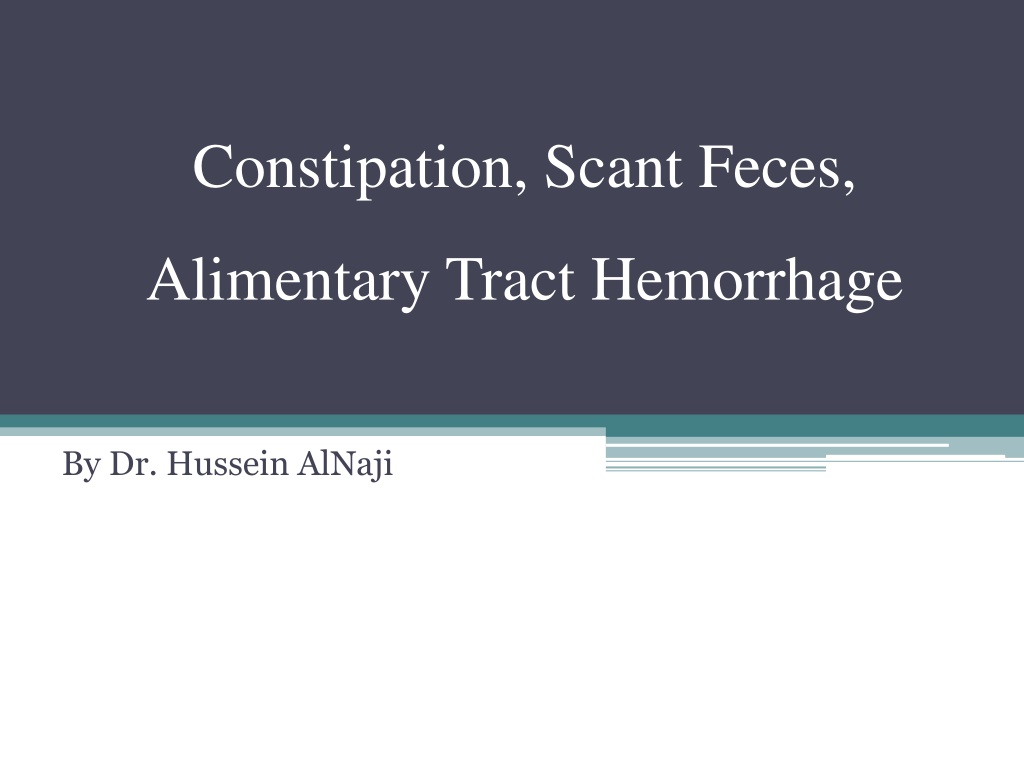Understanding constipation, scant feces, and alimentary tract hemorrhage in farm animals
Constipation in farm animals is characterized by decreased frequency of defecation and dry, hard feces. Scant feces are small quantities of feces, commonly seen in animals with stomach abnormalities. Alimentary tract hemorrhage can result from various causes, including ulcers and infestations. Hemorrhage into the stomach or intestine can lead to changes in vomitus and feces appearance. Identifying these conditions and their mechanisms is crucial for effective management in farm animal health.
Download Presentation

Please find below an Image/Link to download the presentation.
The content on the website is provided AS IS for your information and personal use only. It may not be sold, licensed, or shared on other websites without obtaining consent from the author. Download presentation by click this link. If you encounter any issues during the download, it is possible that the publisher has removed the file from their server.
E N D
Presentation Transcript
Constipation, Scant Feces, Alimentary Tract Hemorrhage By Dr. Hussein AlNaji
Constipation decreased frequency of defecation is the accompanied by feces that contain a decreased concentration of water. The feces vary in consistency from being hard to dry and of small bulk. True constipation, as it occurs in humans, is usually characterized by failure to defecate and impaction of the rectum with feces. Constipation may also occur when defecation is painful, such as in cattle with acute traumatic reticuloperitonitis
Mechanisms The motility of the intestine is reduced The alimentary transit time is prolonged the feces are dry, hard, of Increased time afforded for fluid small bulk, and are passed at infrequent intervals
SCANT FECES Scant feces are small quantities of feces, which may be dry or soft. Scant feces are most common in cattle with abnormalities of the forestomach or abomasum resulting in the movement of only small quantities of ingesta into the small and large intestines (an outflow abnormality). Common causes of constipation or scantfeces are as follows:
1. Diseases of the forestomach and abomasum causing failure of outflow 2. Impaction of the large intestine in the horse and the sow 3. Severe debility, as in old age 4. Deficient dietary bulk, usually fiber 5. Chronic dehydration 6. Partial obstruction of large intestine 7. Painful conditions of the anus 8. Paralytic ileus 9. Grass sickness in horses 10.Chronic zinc poisoning in cattle 11.Terminal stages of pregnancy in cows
Alimentary Tract Hemorrhage Hemorrhage into the stomach or intestine is a common occurrence in farm animals. The main causes include the following: 1. Gastric or abomasal (rarely duodenal) ulcers 2. Severe hemorrhagic enteritis. 3. Structural lesions of the intestinal wall, e.g., adenomatosis, neoplasia. 4. Infestation with blood-sucking nematodes, e.g., bunostomiasis, 5. Local vascular engorgement or obstruction as in intussusception and verminous thrombosis
Hemorrhage into the stomach results in the formation of acid hematin, which makes vomitus a dark brown color like coffee grounds, and feces have a black or very dark brown, tarry appearance (melena). The change in appearance of the feces caused by hemorrhage into the intestine varies with the level at which the hemorrhage occurs. 1) If the blood originates in the small intestine, the feces may be brown-black. 2) If it originates in the colon or cecum, the blood is unchanged and gives the feces an even red color. 3) Hemorrhage into the lower colon and rectum may cause the voiding of feces containing of clots of whole blood (hematochezia).
Abdominal Pain The pain associated with diseases of the abdominal viscera causes similar signs regardless of the viscus or organ involved and careful clinical examination is necessary to locate the site of the lesion. Horses 1. Acute pain: Pawing, flank-watching, rolling 2. Subacute pain: Lesser degree of flank-watching, often excessive pawing, lying down frequently without rolling, stretching out as if to urinate, males may extrude the penis, walking backward, dog-sitting posture, lying on back, impulsive walking 3. Peritoneal pain: Rigidity of the abdominal wall, pain on palpation.
Cattle 1. Acute pain: Downward arching of back with treading of the hind feet, lying down (rolling is uncommon), calves will lie down and bellow with severe abdominal pain, as in abomasal torsion. 2. Subacute pain, including peritoneal pain: Back arched upward, grunting on walking or lying down, grunting on deep palpation of the abdomen, immobility.
Common Causes OfAlimentary Tract Pain Horses 1. Acute pain: All causes of intestinal obstruction, gastric dilatation, enteritis generally, acute colitis, rarely salmonellosis. 2. Subacute pain: Thromboembolic colic, impaction of the large intestine, ileal hypertrophy. Cattle 1. Acute pain: Intestinal obstruction, especially by phytobezoars; poisoning 2. Subacute pain: Traumatic reticuloperitonitis and peritonitis generally, abomasal volvulus.
TENESMUS Tenesmus, or persistent straining, is common in many diseases of the organs of the pelvic cavity; therefore, it is not necessarily a diagnostic sign of disease in the lower alimentary tract. It is sometimes associated with frequent defecation caused by neurologic stimulation of peristalsis. Common causes of tenesmus.
Cattle 1. Lower alimentary tract disease, e.g., colitis and proctitis caused by Coccidiosis. 2. Genital tract disease, e.g., severe vaginitis, retained placenta 3. Estrogen toxicity in steers, e.g., estrogen implantation, fusariotoxicosis 4. Aminopyridine poisoning, methiocarb poisoning 5. Lower spinal cord lesions: spinal cord abscess, rabies 6. Idiopathic Horses 1. Tenesmus does not usually occur except during parturition.

 undefined
undefined
































